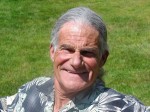The Season for Shake and Bake

It sure was a dank Monday here at the beach, but there was bright sunshine all day at Top of the World. As long as you were above about 500 feet the skies were good to go. That’s how condensed the marine layer was today. Sure it was cold and clammy at the beach, but it’s O.K because like the old saying goes, the worst day in Laguna is 40,000 times better than the best day in Pomona!
Last Wednesday and Thursday sure were great, weren’t they? The best part was we got the heat and super clear skies minus the dangerous dry devil winds. It was nice to see a couple Catalina sunsets too. Interestingly enough the hottest town those two days was Santa Barbara, of all places, with 103 degrees, thanks to what is locally known there as a “sundowner.” Hot, dry offshore breezes funnel through a narrow gap out of the Santa Barbara Mountains usually around sunset time. It’s pretty rare but when it happens the thermometer goes hogwild, having reached up to 113 degrees a couple times in the past.
On Oct. 17, 1989, the Hayward Fault under the Santa Cruz Mountains served up a 6.9 shaker that disrupted everybody from Monterey to the Bay area. Over the years October has been a busy month seismically. We had the 5.7 in Lytle Creek near Mt. Baldy in October 1957, the 6.0 at Whittier Narrows on Oct. 1, 1987, the Upland shaker of 5.7 in 1988, the Loma Prieta temblor on Oct. 17, 1989, and a 7.3 banger on Oct. 15, 1999.
I’m getting nervous. It’s been quiet around here for quite some time now. A number of faults in and around Southern California are way overdue including the San Andreas, the San Jacinto and the Newport Inglewood, which historically pops out a 6.0 or stronger every 60 years or so. The last time it went off was March 10, 1933, when a 6.4 struck at 6 p.m. and really flattened Long Beach even though the epicenter was under the power plant at Newland Street in Huntington Beach. Damage from that one was extensive due to the shallowness of the quake (6 miles). Then there’s the Christianitos Fault near San Juan Capistrano, which destroyed the mission there on Dec. 8, 1812, and that fault is 75 years overdue.
See you next week, aloha!
Dennis McTighe served as a meteorologist at Hickam Air Force Base, Hawaii from 1969 to 1972, and was an NOAA forecaster and earned a degree in Earth Sciences from UC San Diego and has been keeping daily weather records since 1958.




